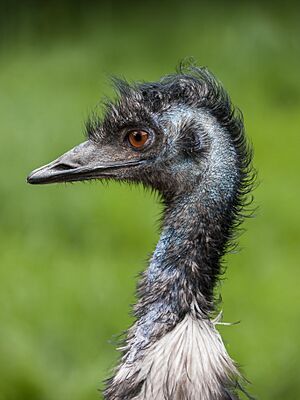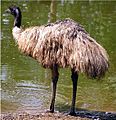Palaeognathae facts for kids
The Palaeognathae (pronounced pay-lee-OG-nath-ee) are a special group of birds. They are one of the two main types of birds alive today. The other group is called Neognathae. All birds, including these two groups, belong to a larger family called Neornithes.
The word "Palaeognath" comes from ancient Greek and means "old jaws." This name refers to how their jaw bones are built, which looks more like the jaw structure of ancient reptiles than other modern birds. Scientists believe that palaeognaths are the oldest and most basic type of living birds, even though there's still some debate about their exact family tree.
This amazing group includes four types of birds that cannot fly, called ratites. It also includes one type of bird that can fly, called tinamous.
Contents
Meet the Living Palaeognaths
Palaeognaths are a diverse group, meaning they come in many shapes and sizes! Let's meet the living members of this ancient bird family.
Flightless Giants: Ratites
Most palaeognaths are known for being large, flightless birds. They are often called "running-birds" because they rely on their strong legs to move around.
Ostriches: The Biggest Birds
- The order Struthioniformes includes just one living species: the ostrich.
- Ostriches are the largest and heaviest birds on Earth.
- They live in Africa and are famous for their long legs, long necks, and incredible running speed.
- They can run up to 70 kilometers per hour (43 miles per hour)!
Emus and Cassowaries: Australian Wonders
- The order Casuariiformes has two types of birds.
- Cassowaries (Casuarius) have three species and live in the rainforests of New Guinea and Australia. They are known for their bright blue heads, helmet-like crests, and powerful kicks.
- Emus (Dromaius) have one living species and are the second-largest birds in the world. They live all over Australia and are very fast runners.
Rheas: South American Runners
- The order Rheiformes includes rheas.
- There are two species of rheas, both found in South America.
- They look a bit like smaller ostriches and are also excellent runners, living in grasslands and open plains.
Kiwis: New Zealand's Night Birds
- The order Apterygiformes includes kiwis.
- There are five species of kiwis, all unique to New Zealand.
- Kiwis are unusual because they are small, nocturnal (active at night), and have long beaks with nostrils at the end, which they use to sniff out food.
Flying Cousins: Tinamous
- The order Tinamiformes includes tinamous.
- There are 47 species of tinamous, and they are the only palaeognaths that can fly!
- They live in Central and South America, often found in forests and grasslands.
- Even though they can fly, they prefer to walk or run and only fly short distances when they need to escape danger.
Birds from the Past
Besides the living palaeognaths, there were also many amazing types that are now extinct. These birds give us clues about how palaeognaths evolved over millions of years.
- The Lithornithiformes were ancient flying birds that lived a long time ago.
- The Dinornithiformes included the moas, giant flightless birds from New Zealand that are now extinct. Some moa species were taller than humans!
- The Aepyornithiformes included the elephant birds, massive flightless birds from Madagascar. They were the heaviest birds ever known.
Scientists are still studying other extinct bird groups to see if they are also related to the palaeognaths.
Pictures
These are the families of running-birds:
-
Moa†
Images for kids
See also
 In Spanish: Paleognatos para niños
In Spanish: Paleognatos para niños













